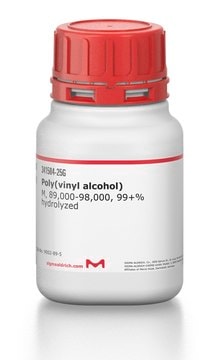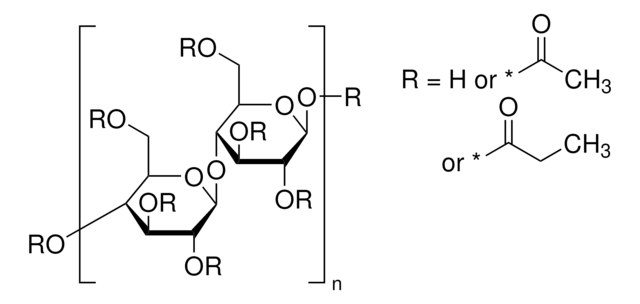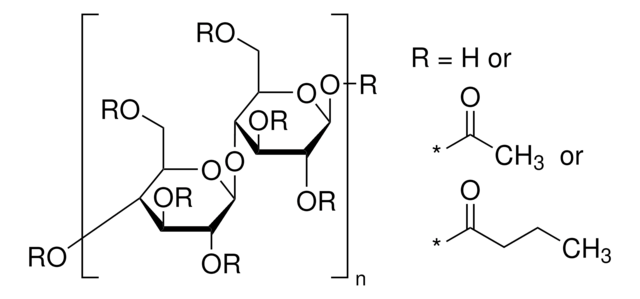419028
Cellulose acetate
average Mn ~50,000 by GPC
Synonym(s):
Acetylcellulose
Select a Size
About This Item
Recommended Products
form
powder
Quality Level
mol wt
average Mn ~50,000 by GPC
extent of labeling
39.7 wt. % acetyl
impurities
≤3.0% water
refractive index
n20/D 1.475 (lit.)
density
1.3 g/mL at 25 °C (lit.)
SMILES string
O1[C@H](C(C(C(C1COC(=O)C)OC(=O)C)OC(=O)C)OC(=O)C)O[C@@H]2C(OC(C(C2OC(=O)C)OC(=O)C)OC(=O)C)COC(=O)C
InChI
1S/C28H38O19/c1-11(29)37-9-19-21(39-13(3)31)23(40-14(4)32)26(43-17(7)35)28(46-19)47-22-20(10-38-12(2)30)45-27(44-18(8)36)25(42-16(6)34)24(22)41-15(5)33/h19-28H,9-10H2,1-8H3/t19?,20?,21?,22-,23?,24?,25?,26?,27?,28+/m1/s1
InChI key
WOTQVEKSRLZRSX-OLIDUAMRSA-N
Looking for similar products? Visit Product Comparison Guide
Related Categories
1 of 4
This Item | 932744 | 749230 | 688096 |
|---|---|---|---|
| form powder | form - | form solid | form powder |
| loss 0.5% loss on heating, 359°C (typical, TGA) | loss 0.5% TGA, >330°C (weight loss) | loss - | loss - |
| transition temp transition temp 437.6 °C (typical, DSC) | transition temp - | transition temp - | transition temp - |
| λmax 282 nm | λmax 287 nm±5 nm in dichloromethane, 373 nm±5 nm in dichloromethane | λmax - | λmax - |
| fluorescence λex 305 nm; λem 507 nm in chloroform | fluorescence λem 514 nm±10 nm in dichloromethane | fluorescence - | fluorescence λex 340 nm; λem 512 nm in chloroform |
General description
Storage Class Code
11 - Combustible Solids
WGK
nwg
Flash Point(F)
Not applicable
Flash Point(C)
Not applicable
Personal Protective Equipment
Choose from one of the most recent versions:
Certificates of Analysis (COA)
Don't see the Right Version?
If you require a particular version, you can look up a specific certificate by the Lot or Batch number.
Already Own This Product?
Find documentation for the products that you have recently purchased in the Document Library.
Customers Also Viewed
Articles
Electrospinning technique applications discussed, emphasizing control of nanofibers and assembly into 3D architectures.
Our team of scientists has experience in all areas of research including Life Science, Material Science, Chemical Synthesis, Chromatography, Analytical and many others.
Contact Technical Service








![Tris[2-phenylpyridinato-C2,N]iridium(III) sublimed grade](/deepweb/assets/sigmaaldrich/product/structures/167/234/658d0b76-d31d-4fd5-8041-e04e207227c9/640/658d0b76-d31d-4fd5-8041-e04e207227c9.png)
![Tris[2-(p-tolyl)pyridine]iridium(III) ≥99% (HPLC)](/deepweb/assets/sigmaaldrich/product/structures/207/957/bb807380-3690-46c2-809e-e6bc2ba29fa5/640/bb807380-3690-46c2-809e-e6bc2ba29fa5.png)
![Dichlorotetrakis[3,5-difluoro-2-(2-pyridinyl)phenyl]diiridium(III) 95%](/deepweb/assets/sigmaaldrich/product/structures/300/702/f03c66ed-f8fa-4103-a508-e57483592685/640/f03c66ed-f8fa-4103-a508-e57483592685.png)


